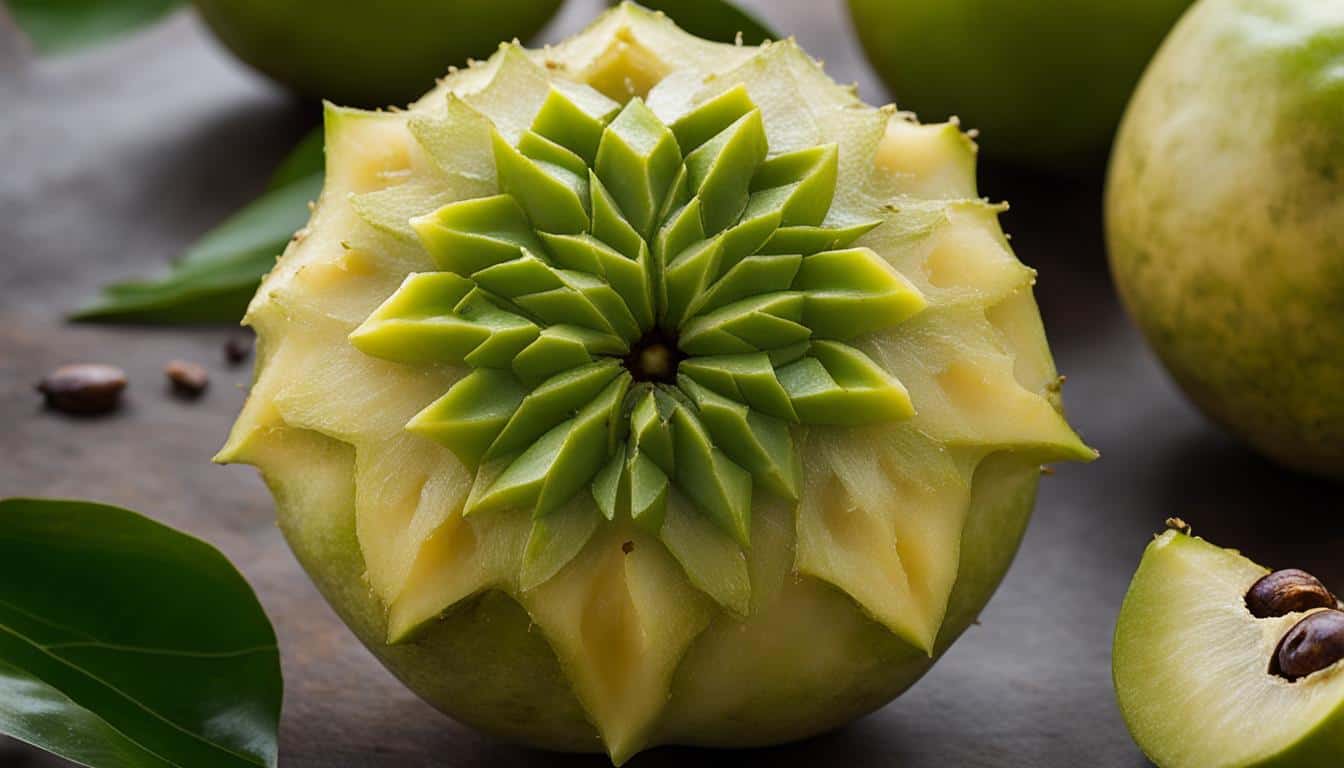Welcome to a journey of flavors as we delve into the world of white sapote, an exotic fruit that will captivate your taste buds. Known for its seductive taste and unique flavor, white sapote, also known as star apple or caimito, is a tropical delight native to Central and South America. Its star-like shape when cut in half adds to its allure, while its soft, creamy flesh and delightful sweetness with a hint of tang make it a culinary sensation.
Key Takeaways:
- White sapote is an exotic fruit with a seductive taste and unique flavor.
- It is also known as star apple or caimito.
- The fruit has a star-like shape when cut in half.
- White sapote’s flesh is soft, creamy, and delightfully sweet with a slight tang.
- Its unique flavor makes it a culinary delight.
The Nutritional Value of White Sapote
White sapote is not only a delicious fruit but also a nutritional powerhouse. It is rich in vitamins and minerals, making it a healthy addition to your diet. It is a good source of vitamin C, which boosts the immune system and protects against illness. It also contains various B vitamins, including thiamin, riboflavin, and niacin, which are essential for maintaining healthy skin, hair, and eyes. Additionally, white sapote has medicinal properties and has been used to treat conditions such as asthma, bronchitis, and allergies. Its diuretic properties also make it beneficial for people with kidney problems or high blood pressure.
Here is a table summarizing the nutritional composition of white sapote:
| Nutrient | Amount per 100g |
|---|---|
| Calories | 81 |
| Protein | 1g |
| Fat | 0.4g |
| Carbohydrates | 21g |
| Fiber | 2g |
| Vitamin C | 20mg |
| Thiamin (B1) | 0.06mg |
| Riboflavin (B2) | 0.03mg |
| Niacin (B3) | 0.5mg |
| Calcium | 15mg |
| Iron | 0.6mg |
As you can see, white sapote is not only a delicious treat but also a nutritious one. Incorporating this exotic fruit into your diet can provide you with a range of vitamins, minerals, and health benefits.
Cultivating White Sapote: Tips for Growing Your Own Tree
If you’re ready to embark on the rewarding journey of growing your own white sapote tree, here are some essential tips to help you get started. With the right cultivation techniques, you can transform your garden into a tropical oasis and enjoy the bountiful harvest of this exotic fruit.
Choosing the Right Location
White sapote trees thrive in warm, tropical climates, so it’s important to select a location that provides ample sunlight and well-draining soil. These trees can tolerate a range of soil types, from sandy to clayey, but ensuring good drainage is crucial to prevent root rot. Plant your white sapote tree in an area that receives at least six hours of direct sunlight every day for optimal growth and fruit production.
Planting and Watering
When planting your white sapote tree, dig a hole that is slightly wider and deeper than the root ball. Place the tree in the hole and backfill with a mixture of soil and organic compost to provide necessary nutrients. Water the tree thoroughly after planting and continue to water regularly, especially during dry periods. However, be cautious not to overwater, as white sapote trees are susceptible to root rot.
Pruning and Maintenance
Regular pruning is essential for maintaining the shape and health of your white sapote tree. Start by pruning any dead or damaged branches as soon as you notice them. Additionally, thin out the branches to increase airflow and sunlight penetration, which promotes better fruit production. Pruning should be done during the tree’s dormant period to minimize stress and encourage new growth in the following season. Remember to sterilize your pruning tools to prevent the spread of diseases.
Fruit Harvest
Patience is key when it comes to harvesting white sapote fruits. These fruits are typically ready for harvest about 6-8 months after flowering. Wait until the fruit’s skin turns a pale yellow or greenish-yellow color and becomes slightly soft to the touch. Gently twist and lift the fruit to detach it from the tree. Be careful not to damage the stem or the surrounding branches during the harvest process.
By following these cultivation tips, you’ll be well on your way to growing your own white sapote tree and enjoying the succulent taste of this exotic fruit right in your own backyard.
Delicious Recipes to Try with White Sapote
White sapote is a versatile fruit that can be enjoyed in a variety of delicious recipes. Whether you’re looking for a refreshing snack, a tropical twist in your beverages, or a decadent dessert, white sapote can elevate your culinary creations. Here are some delightful recipes to inspire your taste buds:
1. White Sapote Smoothie
Start your day with a refreshing and nutritious white sapote smoothie. Simply blend together ripe white sapote, Greek yogurt, a handful of spinach, a splash of coconut milk, and a drizzle of honey. This creamy and tropical smoothie is packed with vitamins and minerals, making it a perfect way to kickstart your morning.
2. White Sapote Salsa
Add a twist to your salsa with white sapote. Dice ripe white sapote, mango, red onion, cilantro, and jalapeno peppers. Squeeze in some lime juice and season with salt and pepper. This fruity and tangy salsa pairs well with grilled fish or as a refreshing dip for tortilla chips.
3. White Sapote Parfait
Indulge in a luscious white sapote parfait. Layer diced white sapote, granola, and Greek yogurt in a glass. Drizzle with honey and sprinkle with toasted coconut flakes. Repeat the layers and top it off with a dollop of whipped cream. This heavenly dessert is the perfect combination of creamy, crunchy, and sweet flavors.
Explore the endless possibilities of white sapote in your kitchen and let its seductive taste take your culinary creations to new heights.
Health Benefits of White Sapote
White sapote not only tantalizes the taste buds but also offers numerous health benefits. This exotic fruit is packed with vitamins and minerals that support overall health and wellbeing. Its unique composition makes it a valuable addition to a balanced diet.
Immune-Boosting Vitamin C
White sapote is a rich source of vitamin C, a powerful antioxidant that supports immune function. Consuming foods high in vitamin C can help protect against illnesses and boost the body’s natural defenses.
Anti-Inflammatory Properties
White sapote contains natural compounds with anti-inflammatory properties. These compounds have been shown to have potential benefits for conditions such as asthma and bronchitis, helping to reduce inflammation in the airways and improve respiratory health.
Diuretic and Cardiovascular Benefits
Studies suggest that white sapote possesses diuretic properties, making it beneficial for individuals with kidney problems or high blood pressure. It can help promote urine production and reduce fluid retention, supporting healthy kidney function. Additionally, the fruit’s high potassium content may contribute to its cardiovascular benefits.
| Health Benefit | Description |
|---|---|
| Immune Support | Rich in vitamin C, which boosts the immune system |
| Anti-Inflammatory | Contains natural compounds that help reduce inflammation |
| Diuretic Effects | Promotes urine production and may aid kidney function |
| Cardiovascular Support | High potassium content may be beneficial for heart health |
Enjoying white sapote can be a delicious way to enhance your health. Whether you choose to savor its sweet flesh on its own or incorporate it into a variety of recipes, this exotic fruit offers a wide range of benefits. Embrace the health benefits of white sapote and indulge in its sumptuous taste.
The Ornamental Beauty of White Sapote Trees

White sapote trees are not only a source of delicious fruit but also add beauty to any garden. They are known for their attractive foliage, with glossy leaves that shimmer in the sunlight. The trees also produce fragrant flowers that bloom in clusters and emit a delicate, jasmine-like scent. These ornamental features make white sapote trees a stunning addition to any landscape. Moreover, they are drought-tolerant and relatively low maintenance, making them suitable for those with busy lifestyles. Growing a white sapote tree can enhance the visual appeal of your outdoor space.
The Beauty of White Sapote Trees
White sapote trees are not just a culinary treasure but also a visual delight for any garden. Their glossy leaves and fragrant flowers create an enchanting ambiance that enhances the overall aesthetics of your outdoor space. Whether you have a small backyard or a sprawling landscape, a white sapote tree can be the centerpiece that adds a touch of tropical beauty to your surroundings.
“The glossy leaves and fragrant flowers of white sapote trees create an enchanting ambiance in any garden.”
What makes white sapote trees even more appealing is their low maintenance nature. They are drought-tolerant and can withstand various weather conditions, making them ideal for busy individuals who want to enjoy the beauty of nature without extensive upkeep. With minimal effort, you can have a stunning white sapote tree that not only provides delicious fruit but also serves as a visual focal point in your garden.
Transform Your Outdoor Space with White Sapote Trees
Imagine stepping outside into your garden and being greeted by the sight of a magnificent white sapote tree. Its lush foliage, shimmering leaves, and delightful fragrance instantly transport you to a tropical paradise. Whether you have a formal garden, a cozy backyard, or a spacious courtyard, a white sapote tree can infuse your outdoor space with natural beauty and a touch of exotic allure.
- Choose the perfect spot for your white sapote tree, ensuring it gets plenty of sunlight.
- Select well-draining soil and provide regular watering in the early stages of growth.
- Prune the tree to maintain its shape and promote healthy fruit production.
- Sit back, relax, and watch as your white sapote tree grows, adding elegance and charm to your surroundings.
With its ornamental beauty and delicious fruit, the white sapote tree is truly a remarkable addition to any outdoor space. Whether you’re an avid gardener or simply appreciate the wonders of nature, cultivating a white sapote tree can bring joy and visual appeal to your surroundings. So why wait? Start transforming your garden with the ornamental beauty of white sapote trees today.
The Wonder of Caimito
Caimito, also known as star apple or purple star apple, is another name for white sapote. This delicious tropical fruit is renowned for its sweet and slightly tangy flavor. Its skin can range in color from green to purple, and when cut in half, it reveals a mesmerizing star-like pattern. Caimito trees can reach up to 50 feet in height and produce round or oval-shaped fruits, typically measuring 4-6 inches in diameter. This fruit is highly nutritious, boasting a range of vitamins and minerals that promote overall health. It is no wonder that caimito has become a beloved fruit among tropical fruit enthusiasts.
The Alluring Caimito
The allure of caimito lies not only in its vibrant colors and star-like pattern but also in its delightful taste. When you take a bite of caimito, you’ll be greeted with a burst of sweetness, complemented by a subtle tanginess that keeps you coming back for more. Its smooth and creamy texture adds to the indulgence, making it a truly decadent treat.
Not only is caimito a feast for the taste buds, but it also offers a range of health benefits. Packed with vitamins and minerals, including vitamin C and potassium, caimito supports a healthy immune system and helps maintain proper bodily functions. It is also a good source of dietary fiber, which aids in digestion and promotes a feeling of fullness.
Caimito in Culinary Delights
Caimito’s unique flavor and texture make it a versatile ingredient in various culinary creations. You can enjoy caimito fresh, sliced and added to fruit salads for a refreshing and exotic twist. It can also be used in smoothies, giving them a luscious tropical flavor. Furthermore, caimito can be incorporated into desserts such as sorbets, ice creams, and pies, adding a touch of elegance and tropical flair.
Where to Buy and Enjoy White Sapote

If you’re eager to indulge in the sumptuous taste of white sapote, you may be wondering where to find this exotic fruit. White sapote can typically be found in specialty grocery stores or farmer’s markets that specialize in tropical fruits. Some online retailers also offer the fruit for purchase and delivery. Additionally, you can try your luck at local orchards or gardening centers that may have white sapote trees for sale. Exploring these sources will allow you to discover the pleasure of white sapote firsthand.
Online Retailers
If you prefer the convenience of shopping from the comfort of your own home, there are several online retailers that offer white sapote for purchase. These retailers often source their fruits from reputable growers and can deliver them directly to your doorstep. Be sure to read reviews and check the retailer’s shipping policies to ensure you receive the freshest white sapote possible.
Farmers Markets
Farmers markets are a great place to find fresh and locally sourced produce, including white sapote. These markets often feature specialty vendors who specialize in exotic fruits and offer a wide variety of options for you to choose from. Visiting a farmers market not only allows you to purchase white sapote but also provides an opportunity to support local growers and learn more about the fruit.
Local Orchards and Gardening Centers
If you have a green thumb and are interested in growing your own white sapote tree, local orchards and gardening centers may have saplings available for purchase. These establishments can provide valuable advice on how to care for the tree and ensure its optimal growth. By cultivating your own white sapote tree, you can enjoy the satisfaction of harvesting your own fruits and have a continuous supply of this delectable exotic fruit.
Conclusion
White sapote is truly an exotic fruit that has captivated my taste buds with its seductive flavor. This culinary delight offers a unique and delightful experience that is sure to transport you to tropical bliss. Not only is white sapote a treat for the senses, but it also boasts impressive health benefits.
The nutritional value of white sapote is remarkable, as it is packed with vitamins and minerals that contribute to overall wellbeing. With its high vitamin C content, this exotic fruit boosts the immune system and protects against illness. Additionally, white sapote contains essential B vitamins that promote healthy skin, hair, and eyes.
If you’re inspired to grow your own white sapote tree, you’ll be rewarded with not only a bountiful harvest of delicious fruit but also the ornamental beauty of glossy leaves and fragrant jasmine-like flowers. These trees are relatively low maintenance and can enhance the visual appeal of your outdoor space.
Whether you choose to indulge in mouthwatering recipes or simply enjoy the fruit as a refreshing snack, white sapote is a culinary adventure worth embarking on. So don’t miss out on the opportunity to savor the sumptuous taste and explore the health benefits of this exotic fruit.
FAQ
Can white sapote be found in regular grocery stores?
White sapote is generally found in specialty grocery stores or farmer’s markets that specialize in tropical fruits. Some online retailers also offer the fruit for purchase and delivery. It may also be available at local orchards or gardening centers that sell white sapote trees.
How tall do white sapote trees grow?
White sapote trees are medium-sized and can grow up to 50 feet tall.
What is the best location to plant a white sapote tree?
Choose a location with well-draining soil and plenty of sunlight when planting a white sapote tree.
How do I care for a white sapote tree?
Regular watering, especially during the tree’s early growth stages, is necessary. Pruning is also important to maintain the tree’s shape and promote healthy fruit production.
What can white sapote be used for?
White sapote can be sliced and enjoyed as a refreshing snack, used to make jams, jellies, and preserves, added to smoothies and juices, or chilled and eaten with a spoon as a refreshing dessert.
What are the health benefits of white sapote?
White sapote is rich in vitamins and minerals, including vitamin C, various B vitamins, and has anti-inflammatory properties. It is believed to have diuretic properties as well, which can be beneficial for kidney problems or high blood pressure.
Why are white sapote trees considered ornamental?
White sapote trees are known for their beautiful, glossy leaves and fragrant flowers that have a delicate, jasmine-like scent, making them a stunning addition to any landscape.
Is caimito the same as white sapote?
Yes, caimito is another name for white sapote. It is also known as star apple or purple star apple.
Where can I buy white sapote?
White sapote can typically be found in specialty grocery stores or farmer’s markets that specialize in tropical fruits. Some online retailers also offer the fruit for purchase and delivery. Local orchards or gardening centers may also sell white sapote trees.





Leave a Reply